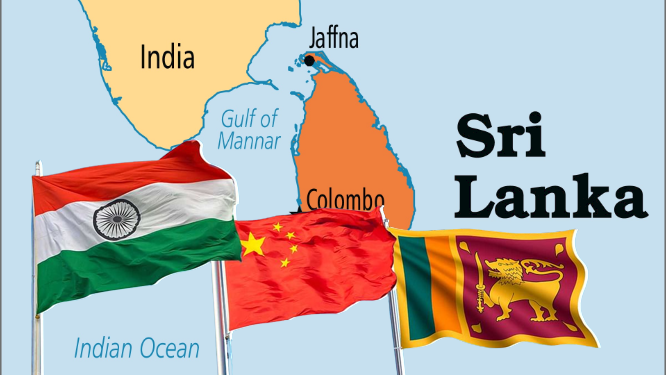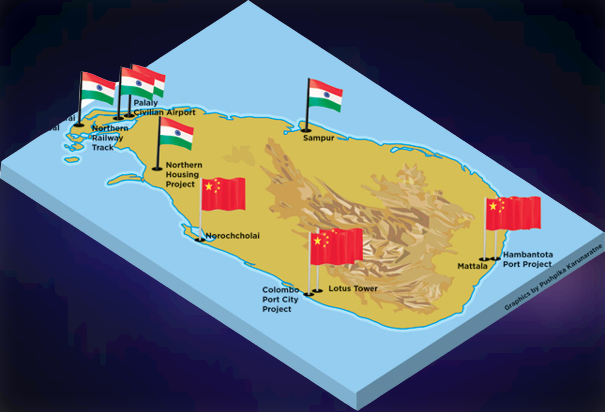
- This strategy of China has led countries like Pakistan and Sri Lanka to become subjects of neo-colonialism, where the sovereignty of the state gets challenged.
- For the past few years, under the banner of the ‘Neighborhood First’ Policy, India has been helping Sri Lanka at different levels.
- Despite Sri Lanka often tilting towards China, India’s moral duty and strategic interest are to help Sri Lanka.
- In the face of Chinese expansion and strategic exploitation, the countries neighbouring India should work together to counter the growing Chinese influence in the region.
Brief Background of the Sri Lankan Crisis
Many vehicles are parked in queues waiting for oil, and citizens trying to storm into the presidential palace and government offices are some of the events that have happened since the economic meltdown of Sri Lanka. For many, the handling of Sri Lanka’s economy by the Rajapaksa government is the main reason leading to the financial crisis; however, the crisis has its roots in the time of the civil war in Sri Lanka. During that time, a massive part of finance was given to the military, and in between the struggle, Sri Lanka couldn’t develop in the globalized economy. After the end of the Civil war in 2009, Sri Lanka started depending heavily on imports for goods and services than increasing its exports leading to low foreign currency reserves.
In later years, Sri Lanka, which lacked infrastructure and development, also began depending on countries and international institutions for loans. Countries such as China, Japan, and India turned out to be the biggest lenders, and China specifically used this dependency on Sri Lanka by providing short-term loans at a higher interest rate. The major setback to Sri Lanka’s economy was the surge of Covid 19, which impacted the revenue earned from the tourism industry and remittance from citizens living abroad. However, the downfall of the tourism sector is of lesser significance when compared to the destructive policies introduced by the Rajapaksa government.
Gotabaya, after winning elections in 2019, delivered his election campaign promise of tax reduction, but this cost Sri Lanka a major source of revenue. The inability to afford imports of fertilizers gave way to a complete crop failure. In April 2022, Sri Lanka announced a debt default of 51 billion as a measure to handle the economic crisis. Later in May, Ali Sabri, the finance minister of Sri Lanka, stated that the usable foreign exchange reserves amounted to less than 50 million. The political instability caused by the resignation and fleeing of government officials also demotivated international institutions from lending financial support.
Amidst the high inflation rates and political turmoil in Sri Lanka, the world has also been simulating the relevance of the crisis in the international arena by looking at the Chinese influence on Sri Lanka and how emerging countries like India are helping Sri Lanka in the face of Chinese strategic expansions. The ongoing crisis in Sri Lanka plays a massive role in current world politics and has different implications for the major powers in Asia. The stand taken by China and India during the Sri Lankan crisis, in a way, depicts the strategic relevance of the ongoing crisis.
China’s Stand on the Sri Lankan Crisis
For China, Sri Lanka plays a prominent role in fulfilling its various strategic interests, and this can be understood well with the example of the Chinese Belt and Road Initiative in Sri Lanka. The BRI focuses on enhancing China’s strategic foothold in the world through increasing connectivity by establishing trade routes and infrastructural projects in countries of its interest. Under BRI, China has invested heavily in various infrastructural projects in Sri Lanka, and a prominent example of the same was the development of the Hambantota port. This port was vital to China as it provided connectivity between the east and west and could reduce China’s vulnerability in the strait of Malacca. Moreover, the Hambantota port is situated on the route used annually by 36000 ships, including 4500 oil tankers pass, and is just about 160 kilometres from India.
Despite having a long partnership with Sri Lanka and having financial collaboration in various projects, China did not heed the requests of Sri Lanka for financial support.

These interests of China in the Hambantota port arguably led to the Chinese debt trap diplomacy in Sri Lanka. The Short-term loans given at higher interest rates to the Sri Lankan government to develop the infrastructure of the Hambantota port at the hands of Chinese companies helped China to gain a 70% stake in the port for a 99-year lease for 1.1 billion dollars. This strategy of China has led countries like Pakistan and Sri Lanka to become subjects of neo-colonialism, where the sovereignty of the state gets challenged.
Since the worsening of Sri Lanka’s economic crisis in the early months of 2022, China, despite having a long partnership with Sri Lanka by being its supporting ally in the UNSC, having financial collaboration in various projects, did not heed the requests of Sri Lanka for financial support. In March, Sri Lanka, after signing a deal with India guaranteeing a billion dollars in the credit line, approached China requesting a loan of 2.5 billion credit which hasn’t yet been approved. Former President Gotabaya in June also called out on China, saying that China doesn’t like to lend loans to cover up earlier debt repayments and added, “My analysis is that China has shifted their strategic focus into Southeast Asia,”. Sri Lanka has also requested China to restructure the debt that needs to be repaid. However, in a recent update regarding the restructuring of loans, China vaguely stated, “The ball is in Sri Lanka’s”.
India’s Stand on the Sri Lankan Crisis
For the past few years, under the banner of the ‘Neighborhood First’ Policy, India has been helping Sri Lanka at different levels. This was also seen during Covid 19 when India sent free doses of vaccines to help Sri Lanka combat the virus. However, the prominence now being given to the ‘Neighborhood First’ Policy comes when China is trying to increase its strategic position in the Indian Ocean with the help of Sri Lanka. Unlike any other country, India has given Sri Lanka much-needed support. In March, India signed a deal guaranteeing Sri Lanka 1 billion dollars in the credit line for the supply of essential goods.
The financial assistance given by India to Sri Lanka is inevitable due to the Chinese influence in the region.
The biggest challenge for Sri Lanka during the economic crisis was the energy shortage, and during June and mid-July, the Sri Lanka Indian oil corporation, a subsidiary of the Indian oil corporation, was the only body that was providing fuel. In a tweet, the Indian High Commission also mentioned that 21000 tons of fertilizers had been sent to Sri Lanka, “Adding to the fragrance of friendship and cooperation”. The commission also added, “This follows 44,000 tonnes supplied last month under Indian support totalling about USD 4 billion in 2022.”
The financial assistance given by India to Sri Lanka is inevitable due to the Chinese influence in the region. For example, in August, Sri Lanka cleared a Chinese spy ship to be docked in the Hambantota port, just about 160 kilometres from India. Despite Sri Lanka often tilting towards China, India’s moral duty and strategic interest are to help Sri Lanka. In other words, India cannot afford bad relations with Sri Lanka.
Conclusion
Sri Lanka understands the strategic importance of its territory to India and China and tries to get the best deal from both these countries. In the past, when situations arise, Sri Lanka has often shown a slight tilt towards China. This was visible when Sri Lanka handed over the East container terminal project to a Chinese company, which was initially given to India and Japan. However, recently there has been a shift of interest towards India, which can be seen in the suspension of energy projects in Jaffna, which was initially planned to be given to a Chinese company. Moreover, the stance taken by India and China during the economic crisis has also helped Sri Lanka identify who its true allies are.
The unfolding of the Sri Lankan Crisis has also been a lesson to the neighbouring countries of India, such as Nepal, Pakistan, Myanmar, etc. These countries depend heavily on Chinese loans, and just like Sri Lanka, they also face a lack of debt sustainability and a balance of payment crisis. The dependency of these countries on short-term, high-interest Chinese loans has tampered with their possibility of achieving long-sustaining growth. In the face of Chinese expansion and strategic exploitation, the countries neighbouring India should work together to counter the growing Chinese influence in the region. It is in the best interest of these states to cooperate with India, as India, unlike China, which works for its political appeal, seeks to establish regional stability.
(Austin Paul, Research Scholar, Department of International Relations, Peace and Public Policy (IRP&PP), St. Joseph’s University (SJU). Dr Karamala Areesh Kumar teaches in the Department of International Relations, Peace and Public Policy (IRP&PP), St. Joseph’s University (SJU). India. Opinions expressed are the author’s own.)
